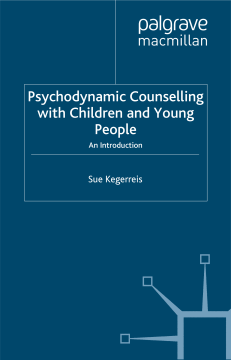
Additional Information
Book Details
Abstract
Introducing key psychodynamic theory, concepts and techniques, this text examines the challenges and opportunities of counselling adolescents and children. The book explores a wide variety of settings and contexts, from schools to community projects and mental health services. It is an invaluable guide for counsellors and therapists at all levels.
SUE KEGERREIS is a Senior Lecturer in the Centre for Psychoanalytic Studies at University of Essex .
Table of Contents
| Section Title | Page | Action | Price |
|---|---|---|---|
| Cover | Cover | ||
| Contents | vii | ||
| Acknowledgements | x | ||
| PART I: KEY THEORIES AND TECHNIQUES | 1 | ||
| 1 Introduction | 3 | ||
| The need for childhood counselling | 3 | ||
| Structure of the book – finding your way around | 6 | ||
| 2 Key theoretical ideas in psychodynamic thinking | 12 | ||
| The unconscious | 12 | ||
| The inner world | 14 | ||
| Containment | 18 | ||
| Transference | 19 | ||
| Countertransference | 20 | ||
| 3 Key elements of psychodynamic technique 1 | 22 | ||
| Introduction | 22 | ||
| Techniques used in the psychodynamic approach | 23 | ||
| Practical equipment | 25 | ||
| The psychodynamic toolbox | 26 | ||
| 4 Key elements of psychodynamic technique 2 | 37 | ||
| Family trees | 37 | ||
| Working with and working in transference and countertransference | 44 | ||
| Working in the metaphor | 48 | ||
| Interpretations and reality | 49 | ||
| 5 The developmental perspective | 52 | ||
| Early years | 53 | ||
| Puberty and adolescence | 56 | ||
| Mid-adolescence | 57 | ||
| Later adolescence | 59 | ||
| 6 Learning – the hardest task of all | 62 | ||
| 7 Using play and art | 73 | ||
| Reading play | 73 | ||
| Working with art materials | 78 | ||
| 8 Behaviour | 82 | ||
| PART II: THE DYNAMICS OF THE COUNSELLING RELATIONSHIP IN CONTEXT | 89 | ||
| 9 Understanding and working with groups | 91 | ||
| Projection and roles in groups | 94 | ||
| Gang dynamics | 96 | ||
| 10 Consent and clienthood | 100 | ||
| Who is the client? | 101 | ||
| Turning referrals into clients | 102 | ||
| 11 Working with difference | 109 | ||
| Culturally sensitive practice | 112 | ||
| Racism | 115 | ||
| Differences in sexual orientation | 119 | ||
| Differences in physical and intellectual ability | 124 | ||
| 12 Working in different settings | 126 | ||
| Schools | 127 | ||
| 13 Family consultation centres, community adolescent services and beyond | 139 | ||
| Child and adolescent mental health services/family consultation centres | 139 | ||
| Community-based services | 143 | ||
| Medical settings | 146 | ||
| Other possible settings | 151 | ||
| 14 Short-term and time-limited work | 152 | ||
| Agencies and time | 154 | ||
| Time-limited work | 155 | ||
| Open-ended short-term work | 160 | ||
| 15 Assessment | 164 | ||
| What is the problem? | 164 | ||
| Whose problem is it? | 166 | ||
| Is counselling the right resource? | 168 | ||
| Is this case suitable for this counsellor? | 170 | ||
| Is the child available enough for the work? | 171 | ||
| Anxieties and defences | 171 | ||
| Who am I to this child? | 173 | ||
| The child's inner emotional world | 174 | ||
| Why now? | 174 | ||
| The use of assessment | 175 | ||
| 16 Endings and outcomes | 176 | ||
| References | 186 | ||
| Index | 193 |
